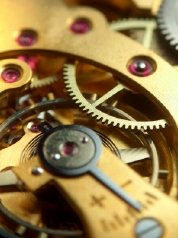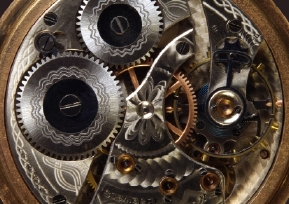|
The Pocket WatchUntil about 1920 the pocket watch was what came to mind when the noun 'watch' was heard. Today it refers to the wristwatch worn every day as a portable personal timepiece. Wristwatches are not a twentieth century invention, however. They were one of the earliest forms of watches dating back to the 1500’s. Queen Elizabeth I of England, the daughter of King Henry VIII and Anne Boleyn who reigned from 1558 until 1603, is believed to be the first person known to have owned a wristwatch. However, most early watches were designed to be worn around the neck like a pendant or attached to the belt.
The Shape of Watches to ComeThe first watches were most likely spherical in shape and the historical record indicates that in 1511 Peter Henlein of Nuremburg devised a watch with an iron movement that was encased in a metal sphere. Contemporary with spherical watches were purse versions of drum-shaped table clocks. These watches struck the hour like the clocks of the day. The brass dial and case of these watches were usually heavily engraved. These early watches also featured a hinged lid similar to the later pocket watch. During the late sixteenth and early seventeenth centuries watches took on various forms, including oval and octagon shapes. In the second half of the seventeenth century, forms became more intricate and included crosses, skulls, birds, animals and flowers. Another type of watch embellishment was enamel decoration. Both watch cases and watch dials were enhanced with enamel. Enamel was already a well-known art form that was exported from France, Germany, Holland and Switzerland before the invention of the watch. A plain white enamel dial was used for watches by watchmakers throughout Europe by 1750. But colorful enameled watch dials and cases depicting a variety of pastoral, religious or mythical scenes were popular. By the end of the seventeenth century, watch technology made a leap forward with the introduction of the balance spring which considerably improved the accuracy of timekeeping of watches. The change in technology also caused the watch to become larger to accommodate the new mechanism and this increased precision allowed the minute hand to be added to the dial.
The Influence of Fashion in ClothingAround the same time clothing fashions for men changed and men began wearing a waistcoat which today is called a vest. In England the waistcoat became mandatory by a royal decree of King Charles II of England in 1666. Men soon began to prefer carrying their watches in the pocket of the waistcoat rather than wearing them as a pendant or attached to the belt. Hence the term 'pocket watch' emerged.
The Pocket Watch in the United StatesThe waistcoat was included in the every day attire of businessmen in the United States until the 1940’s. Even today, a vest continues to be an integral part of the traditional three-piece business suit. The technology available in America reached sufficient maturity by 1845 to support the sophistication needed to manufacture domestic watches. American watch companies dominated the watch market in the United States from the 1850’s until the 1940’s when clock companies abandoned clock and watch manufacturing in favor of producing war material for World War II. The first American watch manufacturer was the Warren Manufacturing Company located in Boston, Massachusetts which began selling domestically produced watches in 1851. After a long and complex history of financial woes and transfers of assets, it was subsequently named the American Waltham Company sometime around 1859. The demand for pocket watches was so great that the Waltham Company manufactured some 35 million watches in the century of its existence, from 1851 to 1957. Another major American name in these watches is the Elgin National Watch Company which produced watches from 1874 until the 1950’s.
Railroad WatchesRailroads provided the backbone of the American transportation system in the late 1800’s and early 1900’s. Since the railroads operated on strict time schedules, the railroad industry was responsible for standardization of time in the United States. The establishment of four major time zones across the continental U.S. was the result of the railroad industry. In 1838 standards for watches to be used by railroad personnel who were responsible for schedules were adopted under the General Railroad Timepiece Standards. Among the standards was one pertaining to accuracy; the railroad watch could gain or lose only thirty seconds per week. Railroad watches were kept in the pocket of the waistcoat of the rail employee’s uniform; railroad watches were indeed pocket watches. Since American companies were manufacturing quality
pocket watches
for the railroads, quality watches were available to businessmen throughout the U.S. The pocket watch remained a prize possession as long as the waistcoat remained in fashion. It wasn’t until the post-World War II era that American men ended their love affair with the pocket watch in favor of the wristwatch.

Need more information?
You can build a great pocket watch collection right from Ebay. If you are looking for something else, just enter it in the search box below.
|





